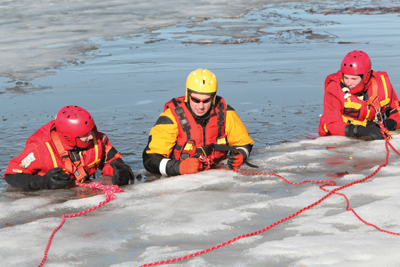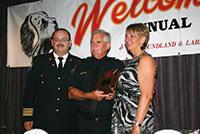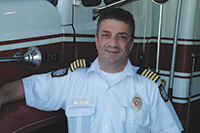
Features
Hot topics
Response
Regionalization
When Premier Kathy Dunderdale of Newfoundland and Labrador addressed a convention of provincial fire chiefs and officers in June, her message was simple and blunt: regionalization and co-operation.
August 4, 2011
By
Laura King
When Premier Kathy Dunderdale of Newfoundland and Labrador addressed a convention of provincial fire chiefs and officers in June, her message was simple and blunt: regionalization and co-operation.
“We do need to look at the most efficient, effective ways of delivering vital services to our residents, and this is true among the fire service,” she said.

|
|
| Fire services are being encouraged to regionalize resources, including specialized services such as water-ice rescue (which is already being done in some areas), and to make better use of response capabilities, particularly in rural areas.
|
Dunderdale, a feisty leader whose relationship with the provincial fire services association is likely among the best in the country – she presented two government cheques to the group – pulled no punches, tackling both fiscal reality and the sacred ground of fire-service tradition.
“I know we are surrounded this evening by numerous departments steeped in history, but the current reality and the future of the fire service rests in our ability to join forces in times of emergency,” she told the 200-plus members of the Newfoundland and Labrador Association of Fire Services (NLAFS) at their annual conference.
“No matter what issues we may have with each other from community to community, when an emergency strikes, public safety is the top priority for us all. Each and every community needs to examine the assets within their own region and look to the possibility of joining together . . . ”
Supporters say that’s the core of regionalization: nixing the egos and he-who-has-the-most-toys-wins attitude among fire-service leaders, and figuring out which departments really need which equipment to adequately respond to calls.
Newfoundland and Labrador is leading the regionalization trend out of necessity: the province is mired in $8.7 billion of debt left over from years of deficit budgeting before offshore oil revenues offset the collapse of the cod fishery. But some fire-service leaders in other provinces recognize that unless they embrace regionalization and create new systems of co-operation, cash-strapped councils will do so for them, with little or no fire-service input. And, they say, nothing good will come of that.

|
|
| Newfoundland and Labrador Premier Kathy Dunderdale (above right) is a proponent of regionalization for the fire service and encouraged fire-service leaders to embrace the notion at the Newfoundland and Labrador Association of Fire Services conference in June.
|
Regionalization is common in municipal services such as policing, garbage collection, recycling and water management. Proponents note that regional police forces – such as the Halton, Peel and York forces in Ontario – work well, and they wonder why there are no regional fire- and emergency-service strategies.
Tim Beckett, president of the Ontario Association of Fire Chiefs, said in a recent Straight Talk column in Fire Fighting in Canada that regional fire services will eliminate duplication, strengthen service delivery and save money for municipalities.
What’s more, he said, fire prevention and public education will be standardized, training will be consistent, and fire stations can be properly positioned and not hampered by boundaries.
“So, why can’t we embrace regional fire services – fire services responding to public need regardless of boundaries and politics, regional departments that share resources to meet the demands of their communities, without duplication?”
Beckett went further, exposing some potentially vulnerable areas in the longstanding argument for more fire-service funding.
“How many hazmat teams, rescue boats or aerials are needed in a region, when the reality is that they are not often used?” he asked.
For supporters, regionalization seems like a common-sense approach to financial challenges, such as those created by standards requiring up-to-date apparatuses (even in remote, volunteer departments in which the trucks are rarely used), or the battle in some parts of rural Canada to recruit and retain volunteers, and then to properly train them.
A different sort of regionalization is happening in Centre Wellington, a mostly rural regional township in south central Ontario, northeast of Kitchener, where Chief Brad Patton recently posted a job for a regional training officer.
As is the case in most volunteer departments, training is a challenge in Centre Wellington, where there are seven departments, 13 stations, 344 volunteer firefighters and 26,000 residents. Like all training officers, those in all seven Centre Wellington departments were tasked with time-consuming and sometimes overwhelming paperwork ranging from lesson plans to accountability sheets for their weekly two-hour training sessions.
And with Ontario’s Ministry of Labour paying closer attention to firefighter training and accountability after two line-of-duty deaths in Listowel in March, a fatal water-ice rescue exercise in January, and a 2009 fire in Meaford at which two firefighters were injured, Patton and the other Centre Wellington chiefs were worried about additional pressure on the volunteer training officers and recognized that senior managers needed to think differently.
In an initiative that is expected to be a model for other Canadian departments, Centre Wellington’s chiefs devised the plan for a regional training officer who will create the lesson plans and site plans for the seven departments, ensure that safety standards are met, and deal with the stacks of paperwork. The volunteer training officers will still run the training sessions, but with a lot less stress and a lot more support.
“Everyone agreed that training was the top priority for the fire department but getting the training is the difficult part,” says Patton. “So we came up with the idea, well, can we share one? And we agreed that something could be worked out.”
The full-time training officer job, which was posted in June and was expected to be filled by mid-July, is funded by the region.
“All seven councils unanimously approved it – there was very little hesitation,” Patton said.
“This could easily be done by seven fire departments, or five, or three fire departments that are like-minded, understand the need, and what the goal is, to get together to fund a position. They don’t even have to be from the same county or region; they just have to be a group that says, this is what we’re going to do, and we’re going to split the cost. It’s far easier for a council to pay a third or a fifth of the cost of a training officer and get good-quality training material.”

|
|
| Centre Wellington Fire Chief Brad Patton spearheaded the drive for a regional training officer to work with the seven departments and 13 stations in the district.
|
So, with seemingly common-sense solutions to fiscal and resource challenges, why the resistance to regionalization? Is there resistance? Or is there a lack of will to shift the fire-service paradigm that all departments should be all things to all people? Is that cultural about-face simply too overwhelming for fire chiefs’ associations to handle? And who needs to be convinced – the fire service or the public?
In Ontario, the firefighters’ union says it is willing to look at the issue. Fred LeBlanc, president of the Ontario Professional Fire Fighters Association, says that while there’s no formal position on regionalization, the OPFFA believes all parties should consider the issue with open minds.
“While there will always be immediate and expected resistance to such a change, as it is human nature, for the fire service and our members it is a discussion that should be explored as it can have long-term benefits for everyone involved, including the citizens we respond to.”
Clearly, regionalization won’t work everywhere. Major centres need fully equipped fire departments. And as Len Garis, newly minted president of the Fire Chiefs Association of B.C., said, governments that support such initiatives are often around for a lot less time than the fire departments that adopt them. “I’d approach it cautiously,” he said of a regional approach to fire fighting, noting, however, that a regional hazmat program on B.C.’s lower mainland has been quite successful.
Regardless, in Newfoundland and Labrador, like everywhere else, money is tight and Premier Dunderdale wants to support fire services across the large, sparsely populated island. And although the province has anted up for new apparatuses to replace some sorely aging fire trucks, Dunderdale is not about to put shiny new kit in every fire bay from St. Anthony to St. John’s. She wants the fire service to get its act together and help to extend the benefit of strategic provincial investments by sharing resources regionally – which could be a challenge if every chief in a particular region wants the shiny new truck in his department, not to mention that the politicians who approved the funding will want the trucks in the communities that elected them.
Proponents of regionalization roll their eyes at such ego-driven turf wars; all stakeholders will need to put some water in their wine to make co-operative fire fighting work for the safety of all communities.
In Newfoundland and Labrador, where there are 300 fire stations and 6,000 firefighters – mostly volunteers – they’re willing to do just that.
“The idea that provincial government must provide everything to everybody has spilled over into a culture, because municipalities don’t have the tax base,” NLAFS president Vince MacKenzie told the Gander Beacon in early July. “We as a fire service, cannot always go with our hand out, unless we commit to running our fire services more effectively and efficiently. We need to meet government halfway.”
Gander Fire Chief Dave Brett told The Beacon, after Premier Dunderdale spoke at the conference, that regionalization might be the key to staffing problems affecting plenty of Newfoundland and Labrador departments.
“There’s a change in the fire service, where the majority of fire departments realize they’re having trouble with membership, so they’re trying to marry this up with the provincial government reducing costs, and sharing resources with neighbouring towns.”
The events of mid-May in Slave Lake, Alta., were an extreme example of regionalization, when firefighters from across Alberta responded to the wildfires that ravaged the town. But the co-operative effort illustrates the point that Premier Dunderdale made on the other side of the country a few weeks later: shared responses and shared solutions are effective and should be economical.
Print this page